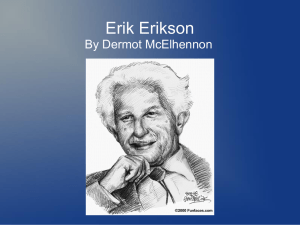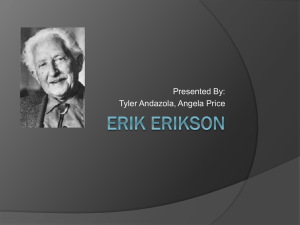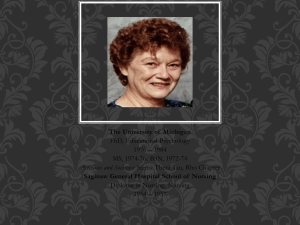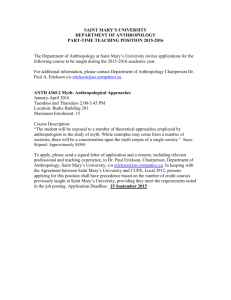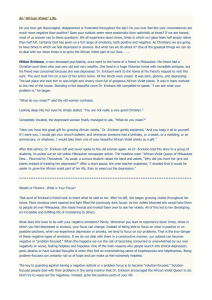The Philosophical Position of the Ericksonian
advertisement
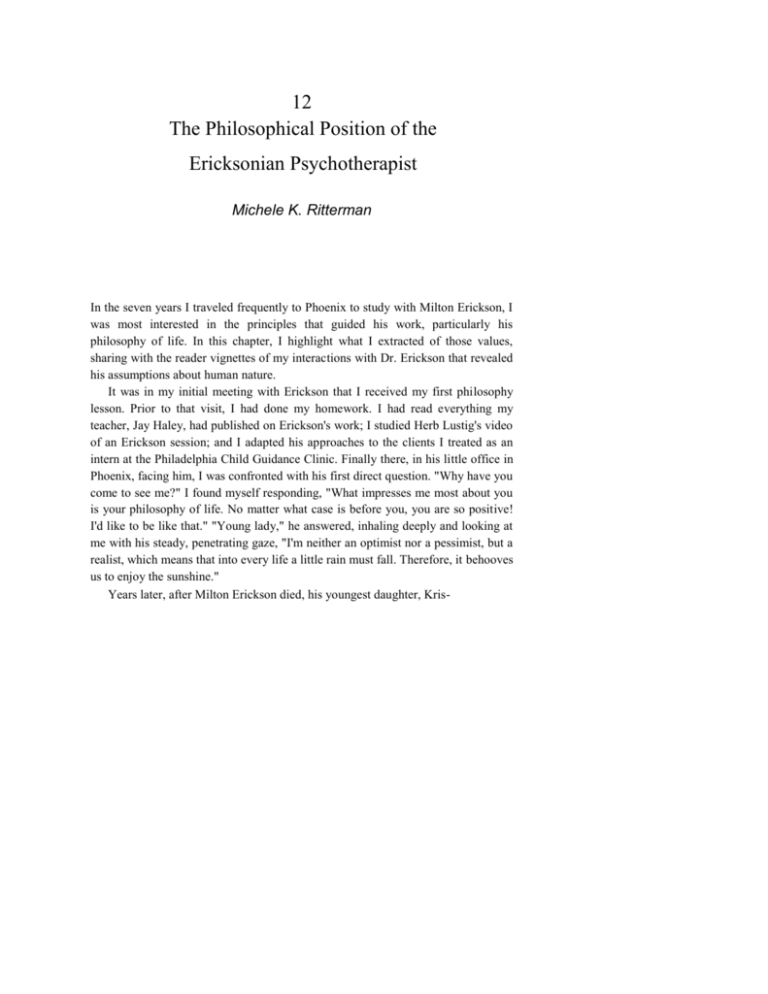
12 The Philosophical Position of the Ericksonian Psychotherapist Michele K. Ritterman In the seven years I traveled frequently to Phoenix to study with Milton Erickson, I was most interested in the principles that guided his work, particularly his philosophy of life. In this chapter, I highlight what I extracted of those values, sharing with the reader vignettes of my interactions with Dr. Erickson that revealed his assumptions about human nature. It was in my initial meeting with Erickson that I received my first philosophy lesson. Prior to that visit, I had done my homework. I had read everything my teacher, Jay Haley, had published on Erickson's work; I studied Herb Lustig's video of an Erickson session; and I adapted his approaches to the clients I treated as an intern at the Philadelphia Child Guidance Clinic. Finally there, in his little office in Phoenix, facing him, I was confronted with his first direct question. "Why have you come to see me?" I found myself responding, "What impresses me most about you is your philosophy of life. No matter what case is before you, you are so positive! I'd like to be like that." "Young lady," he answered, inhaling deeply and looking at me with his steady, penetrating gaze, "I'm neither an optimist nor a pessimist, but a realist, which means that into every life a little rain must fall. Therefore, it behooves us to enjoy the sunshine." Years later, after Milton Erickson died, his youngest daughter, Kris- 188_______________HANDBOOK OF ERICKSONIAN PSYCHOTHERAPY tina, shared with me a variation on that theme. I was then working with torture survivors, people whose bodies and personalities had been shattered by abuse. She said, "I think my father would like you to know something he understood from his having suffered nearly total paralysis caused by polio. He used to say to me, 'Kristina, I find that to do anything is pleasing.'" Combining these ideas, I began to recognize a principle underlying Erickson's work: Start with whatever ray of light, shred of hope, or crumb of real positivity is at hand and help the client to make a realistic step that will enable that person to create further openings from the confines of his or her own mental limitations. Since initially I had come to Milton Erickson as a psychotherapist and a student of Haley's, rather than as a young woman seeking personal counsel, he asked me to begin our discussion by defining my theory of psychotherapy. This conversation revealed Erickson's ideas about transformation in therapy. I proudly rattled off a few sentences about how I worked to change people, rather than analyze them. Unimpressed, he reminded me: "In psychotherapy, the therapist changes absolutely nothing. We create the circumstances under which an individual can respond spontaneously and produce his or her own change. Heartened by the possibility of change—-no matter how small, positive, or negative-—that person will naturally go on to make other changes." As our interaction progressed, and I went deeper into trance, Erickson asked me what I would really like to talk about. To my surprise, a flood of emotions poured forth, and I began talking about wanting to have a child. Immediately afterward, I was embarrassed, and he said, "Now, we can talk about whatever you like. Tell me about one of your cases." He then demonstrated with me, to me, and for me, that whatever the therapist and client are talking about, they are always addressing what is most. important to the unconscious mind, even though it might be in a coded language. He was demonstrating his belief that the human being tips his or her hand or reveals himself or herself in everything he or she does. He loved holograms, because a hologram conveys the essential idea that the | whole can be seen from any part. Although known for indirection, Erick-1 son, in fact, worked very directly, but through whatever personal co^l the client wished to provide. 3 If a person spoke to Erickson in body language, for example, he co 131^ municated directly in body language in return, matching whatever co°|| The Philosophical Position of Ericksonian Psychotherapists_________189 tent or format in which the person wished to speak. He accepted clients' frames of reference. He did not project onto them. He did not analyze them from the perspective of a particular theory of personality. Erickson emphasized that you can know where people are by understanding their unique perspectives. I remember using this wisdom during a horseback riding lesson. I knew absolutely nothing about horses. My teacher was irresponsible. It was nighttime and my second lesson. "This horse is in heat," I complained to my teacher. "How do you know that?" the teacher asked. My reply: "She's ignoring your instructions and paying all her attention to what is going on out the pasture." The horse, like a man or woman having an affair, was distracted. Erickson believed that therapists ought not try to get clients to speak the therapist's language, but rather, should speak directly to clients in their language and about whatever content they choose to use to express their problems. Erickson had no mentor or teacher, it is said. I disagree. Pain was his teacher. If anything can get a person to focus on practical matters, it's the question of what to do about pain. On one visit, we spent seven hours eyeball to eyeball. He said that as long as he was in trance, he could feel no discomfort, but once the trance was broken, he felt as if someone had been rolling a baseball bat up and down his spine. Much of Erickson's work can be understood by looking at how he learned to deal with excruciating pain. The kind of pain he suffered taught him, for example: "If you want to destroy something, analyze it." Of course, he was enjoying a dig at psychoanalysis, but he was also teaching that the way to confront symptoms is to see them in their parts, to decompose them. In this broken-down state, big troubles become manageable ones. He taught that many pains have a "before," a "during," and an "after." He wrote a beautiful paper 1 about how to work with pain in those three stages. His use of paradox related to his observation that people don't like to be told what to do. They don't like you to tell them to stop a problem behavior! It tends to make them dig in their heels and persist. Tell them to keep on doing what they are doing, and even improve on doing it, and they will rebel. If he hoped for a client to carry out an assignment on a -^ *An introduction to the study and application of hypnosis for pain control." In J. Lassiter ;; ,^—)> Proceedings of the International Congress on Hypnosis and Psychosomatic Medicine. Berlin, ^Heidelberg, New York: Springer Verlag. Reprinted from College of General Practice of Canada v, Journal. 190_______________HANDBOOK OF ERICKSONIAN PSYCHOTHERAPY Wednesday, he'd said: "Your mother might prefer you do this on Monday or Tuesday. I, myself, am hoping for Thursday or Friday, and I'm certain your husband would be pleased for it to occur on the weekend." He observed human behavior and from those general observations developed techniques tailored to the unique individuals at hand. Erickson also taught that it is okay if your client thinks you are God, but you'd better not get confused by that. People make mistakes. He said that the Navajo weave an error into every rug to show that only God is perfect. He disliked it when therapists or doctors told people what they were capable of in terms of recovery. His resentment of this attitude dated back to the day when a doctor told his mother that her son would be dead by the next morning. Paralyzed, he was able to get his mother to position a dresser mirror so that he could watch the sunrise from his bed. He managed to be fully conscious at sunrise, long enough for his mother to see that the doctor was wrong, before he lapsed into a coma for several days. He had made his point to his mother. When Kay Thompson and I talked at a workshop in Italy about her amazing recovery from a major accident, she explained that were it not for Milton Erickson's philosophy, she wouldn't have dared envision a physical healing that the doctors said was impossible. Just before that workshop, I had been thrown from the thoroughbred racing horse in heat that my teacher had put me on, and had crushed a bone in my elbow. I was told I'd never straighten that arm again. "How dare you tell me what my arm is capable of doing?" I protested. When the physician wanted to leave the arm in a bent position in a cast after surgery, I knew the arm needed to come out of the cast to prevent it from healing in that position. I had to consult three different doctors before I could find one who would listen to my body. If I had not known Erickson, I would not have believed in my own body and its special healing powers. My arms now are symmetrical. Erickson took his practical understandings of visceral pain and applied them to many other human dilemmas. Troublesome patterns people suffer, such as the abuse cycle, are subject to being broken down into before, during, and after phases. We know from Erickson that each of those three phases of any symptom pattern—whether an individual's mental set or a family's sequences of interaction—gives therapists that many clinical opportunities to enter in, and help to create, a circumstance in which the person can respond spontaneously and change. Working with abuse in The Philosophical Position ofEricksonian Psychotherapists__________191 this manner—treating the fighting, the forgiveness, the building of tensions—helps to destroy the entire symptom pattern. Few psychological symptoms are continuous and nonstop. Erickson learned many of the aforementioned lessons from physical pain. Erickson also learned that some pains, insufferable in one body part, can be tolerated when transferred to another body part: Someone getting a shot, for example, can soften the pain of the needle by digging a fingernail into the fleshy part of the palm. That digging affords control over the pain. Erickson learned that part of what hurts about pain is that it is out of the person's control and, therefore, surprising, and even humiliating. We know that people can change by moving a problem from one facet of life to another where it is less bothersome, but can still keep the problem. Other therapies are less innovative because they are based on theory rather than on the tangibles and practicalities of urgent human suffering. Along with one of Erickson's daughters, I once sat on a panel whose members were asked to discuss their relationship with him. His daughter and I said the same thing: We felt accepted by him. Erickson did not try to change people because they were having trouble, whereas the goal of many therapies is to make better people of clients or to get clients to conform to a prescribed model of mental health. Erickson liked to watch minds open like flowers blooming in the sun. He didn't compare a rose with a sunflower. Despite his reputation as a supreme manipulator, he actually meddled less than any other clinician with whom I've studied. He did as little as necessary because he really did accept people for who they were. Erickson said to me, "You are as unique as your fingerprints. There never has been, and never will be, anyone exactly like you. So you have the right to be that, fully. There are things you can change, but other things are like your fingerprints. You can't change them. So just accept them." He helped people to acquire "the wisdom to know the difference." He also conveyed a complete acceptance of a person's uniqueness. Accepting individuality in part established the basis for his paradoxical work. He said that when, as a teenage athlete, he had been totally paralyzed, except for the use of one eye, he became a keen observer of human behavior. Paradox and other methods came to him simply by observing how people actually work—not by hypothesizing about their childhoods, but by watching them in motion. He noticed that if you ask someone ^ho is running to an appointment to tell you the time, when the person starts off again, it may be in the wrong direction. This observation 192______________HANDBOOK OF ERICKSONIAN PSYCHOTHERAPY formed the basis for his distraction techniques in psychotherapy. Erickson added to this his observation that if you want a baby to put down a knife, you give it something else to pick up and the baby will let go of the knife. Otherwise, that baby will hold on, as if for dear life, to the dangerous object. Likewise, in child rearing in general, and in treating human problems, distraction can allow the mind to open to something new. One of Erickson's favorite tricks was to show highly educated people that their broad and deep studies had not prevented them from suffering a philosophically rigid mental set. He had a lot of ways to shake up minds. One was his brain-teaser puzzle: "A farmer plants five rows of trees, four trees in each row, for a total of ten trees. How is this possible?" I watched him present this riddle to a variety of visitors from around the world. Everyone I saw was stumped by it. I'll leave the reader with this one. Milton didn't give the answer. He once said to me, "You're in your 30s and want to think you know it all right now. If your theory of life were right and mine wrong, life would be deadly dull. I'm in my 70s and I learn something new every day." In summary, Milton Erickson helped me to form a pragmatic and yet intriguing philosophy of psychotherapy. To condense some of the basic ideas, we can consider the eight principles. The Eight Principles Principle One. Be neither a pessimist nor an optimist, but a realist: Help your client to go through the best door that is open. Principle Two. Therapists create the circumstances in which change can occur. It is the client who makes the changes. Principle Three. Therapists need to speak in the client's language, not the other way around. Principle Four. Let (your own) pain be your teacher. Principle Five. Accept the things you cannot change. Principle Six. Observe human behavior. Let those observations, and not some theory, guide your interventions for each unique situation. Principle Seven. Therapists are not gods, but guides. Principle Eight. Therapists don't need to provide answers, they need to provide mind-openers.
![Action Plan Training for College of Education [Erickson Hall]](http://s3.studylib.net/store/data/006838784_1-e08201da1f024d72d03dde66b95777a5-300x300.png)

